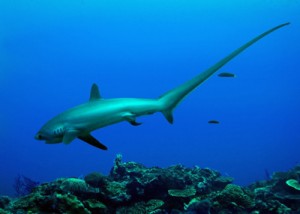Who is the Shark of the Week?!?!?!
The Bull Shark!!!!

The Facts:
Bull sharks are of medium size. They grow between 7 to 11 feet and can weigh up to 500 pounds. They live for an average of 16 years. They are grey on their back and sides and have a white underbelly. They get their name from their rounded snout and the fact that they “head-butt” their prey when attacking. Also, they are named Bull sharks because they have the temperament of bulls. This shark species is one of the most aggressive of the various shark species. This makes them particularly dangerous to humans. The diet of a bull sharks consists of fish (bony fish and rays), dolphins, and even other sharks.
These sharks are swift and agile. They are commonly seen in warm, shallow waters and can be found in all of the world’s oceans. They tend to habitat in regions of high-population rates.
One of the most interesting facts about the Bull shark is that they don’t stick to salt water. Bull sharks have been found in freshwater! Some of these sharks have been found thousands of miles up the Amazon river and in Nicaragua, it was witnessed that they were leaping up river rapids like salmon (Crazy!!!).
Why did the Bull shark make the Top Ten countdown?
The Bull shark is number 7 on the list because of how dangerous they really are. These sharks not only love to be in shallow, highly-populated waters, but the waters don’t even need to be saturated with salt. I think it’s amazing how these sharks are able to go from salt water to fresh water without thinking anything of it.
Also, it has been confirmed that Bull sharks contain the highest amount of testosterone in their body than any other shark species. This is why they are the most aggressive shark species. It’s common knowledge that when you’re around a shark you should be careful, but in the Bull shark’s case…be EXTREMELY careful! Especially since most sharks attacks occur in only a couple feet of water (and did I mention bull sharks love shallow water??).
Grouped with its cousins, the Great White shark and Tiger shark, the Bull shark is one of the sharks responsible for the most shark attacks. Some scientists have even stated that the Bull shark is the most dangerous shark in the world because of it’s habitat versatility and high levels of testosterone.
I was watching Shark Week last summer and they were running an episode of their own shark countdown, only theirs was based on how dangerous they were. As they were listing the Top Three I was positive of the order and was bragging to my parents about how much I know about sharks. I thought it was going to be number three- the Tiger shark, then two- the Bull shark, and number one- the Great White shark. I was wrong. They listed number one as being the Bull shark. I was really surprised until they said it was because they could swim in both salt and fresh water and they were the most aggressive. So, there you have it. The most dangerous shark in the world. You…go…Bull Shark…? Yay..?


